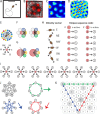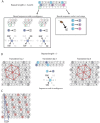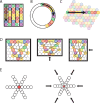This is a preprint.
Spatial periodicity in grid cell firing is explained by a neural sequence code of 2-D trajectories
- PMID: 37398455
- PMCID: PMC10312530
- DOI: 10.1101/2023.05.30.542747
Spatial periodicity in grid cell firing is explained by a neural sequence code of 2-D trajectories
Update in
-
Spatial periodicity in grid cell firing is explained by a neural sequence code of 2-D trajectories.Elife. 2025 May 21;13:RP96627. doi: 10.7554/eLife.96627. Elife. 2025. PMID: 40396463 Free PMC article.
Abstract
Spatial periodicity in grid cell firing has been interpreted as a neural metric for space providing animals with a coordinate system in navigating physical and mental spaces. However, the specific computational problem being solved by grid cells has remained elusive. Here, we provide mathematical proof that spatial periodicity in grid cell firing is the only possible solution to a neural sequence code of 2-D trajectories and that the hexagonal firing pattern of grid cells is the most parsimonious solution to such a sequence code. We thereby provide a likely teleological cause for the existence of grid cells and reveal the underlying nature of the global geometric organization in grid maps as a direct consequence of a simple local sequence code. A sequence code by grid cells provides intuitive explanations for many previously puzzling experimental observations and may transform our thinking about grid cells.
Keywords: cell sequences; grid cells; path integration; trajectory coding.
Conflict of interest statement
Conflicts of Interest: The authors declare no competing interests.
Figures





References
-
- Fyhn M., Molden S., Witter M. P., Moser E. I. & Moser M.-B. Spatial representation in the entorhinal cortex. Science 305, 1258–1264 (2004). - PubMed
-
- Hafting T., Fyhn M., Molden S., Moser M.-B. & Moser E. I. Microstructure of a spatial map in the entorhinal cortex. Nature 436, 801–806 (2005). - PubMed
-
- Boccara C. N. et al. Grid cells in pre- and parasubiculum. Nat. Neurosci. 13, 987–994 (2010). - PubMed
-
- McNaughton B. L., Battaglia F. P., Jensen O., Moser E. I. & Moser M.-B. Path integration and the neural basis of the ‘cognitive map’. Nat Rev Neurosci 7, 663–678 (2006). - PubMed
Publication types
Grants and funding
LinkOut - more resources
Full Text Sources
